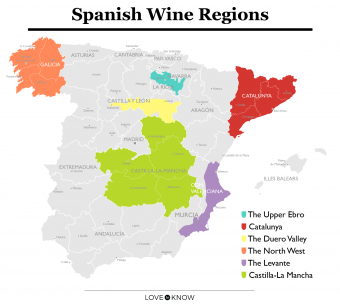
In the wine world, Spain continues to be in the shadow of other big players like France and Italy. But Spanish wine is incredibly diverse, with a mix of international and indigenous grape varieties planted across varying climates. To dive into this stunning wine landscape, it's best to look at the country through geographical regions.
Spanish Wine Regions Map
From the cool northwest coast of Spain to the hot and dry Meseta Central plateau, there are over 130 formal wine denominations across the country that are suited to a range of different grapes and wine styles. The following six geographical regions summarize broader areas based on climate and grape varietals.

Upper Ebro
The Upper Ebro is situated in the northern part of the country, slightly more east than central. With rolling hills turning to foothills nearing the Pyrenees Mountains and the Cantabrian Mountains, vineyards in the Upper Ebro are between 650-1650 feet (200-500m). This region contains one of the most famous Denominación de Origen Calificada (DOCa), Rioja, along with Navarra, Cariñena and Calatayud. Most of the region's climate is influenced by the Atlantic Ocean, with warm summers with cooler, wetter climates in sites closer to the mountains. It's a robust region for red grape varietals from tempranillo, to garnacha, to mazuelo and cariñena with fewer plantings of white grapes of viura, chardonnay, and sauvignon blanc.
Catalunya
Situated in the northeast corner of Spain, Catalunya is home to Barcelona and the important wine regions of Penedès and Priorat. While the northern corner bumps right up against the Pyrenees, it's the southern part of the region that has the highest concentration of vineyards. The climate is mostly Mediterranean, with a mix of temperatures from the coastal plains to the higher hills. This wide spectrum of sites means the region can successfully grow a handful of different grapes from white grapes such as viura, xarel-lo, and parellada for Cava to international varieties such as chardonnay, gewürztraminer, merlot, and cabernet sauvignon. Tempranillo, cariñena, and garnacha thrive in the warmer sites, growing particularly well in the red slate soil speckled with mica, known as llicorella.
Duero Valley
Named after the iconic river that runs all the way into Portugal, the terrain of the Duero Valley varies from alluvial river banks to marl and limestone slopes. The Valley includes the regions of Rivera del Duero, Toro, and Rueda. Sites on the high plateau of Meseta Central can be at elevations of 2,780ft (850m), with cool nights and short seasons. The region is dominated by red wine production, producing concentrated, full-bodied reds with lively acidity. Tempranillo is the most widely planted grape, with significant amounts of garnacha as well. As for whites, verdejo and sauvignon blanc are the main players in the Duero, often expressing good acidity and minerality.
Northwest
The cool, wet, and green Northwest region of Spain is home to some of the most crisp, refreshing, dry whites Spain has to offer. Key wine regions in this part of Spain include Rias Baixas, Bierzo, and Valdeorras. Thanks to the Atlantic ocean, the region sees consistent salty ocean breezes and ample rain, making it a prime growing spot for grapes such as albariño, loureira, torrontés, and treixadura. The primary red grape here is mencia, which is often old vine and expresses great acidity alongside bright red fruit flavors.
Levante
Levante is a coastal region south of Catalunya on the Mediterranean. It includes the wine regions of Valencia as well as Jumilla and Yecla. It's truly a Mediterranean climate with sun-drenched vineyards stretching across vast, arid landscape. While there are some white grapes such as the native merseguera, along with muscat of Alexandria, most plantings are red grapes, as they are better suited to withstand the hot climate. Monastrell is widespread, along with syrah, garnacha, merlot, bobal, cab sauv and tempranillo. Mature, dry-farmed bush vines thrive here, producing thick-skinned, full-flavored grapes with robust character.
Castilla-La Mancha
Castilla-La Mancha is a large geographical region that lies in the central plateau (Meseta Central), south of Madrid. Responsible for over half of Spain's wine production, the landscape here is brimming with vines. It includes the regions of La Mancha, Valdepeñas, Ribera del Guadiana, and Méntrida. The best wines that come out of this area are bold reds with robust character. While there is some lesser quality, budget wine being produced here as well, there is a surprising amount of inexpensive, quality wine to be found for a great value. Airén is a widely planted white grape alongside chardonnay, sauvignon blanc, and native macabeo and malvar. Tempranillo, monastrell, bobal, merlot, syrah, and cab sauv are commonly found red grapes.
Exploring Spain
From the rugged hills of Priorat to the cool and foggy vineyards of Galicia, Spain has a diverse landscape that expresses a wide profile of wines from white to red. Start by exploring the country's wine regions via map and then move to your glass. A tasting flight across Spain is a unique way to experience the diverse terroir.







